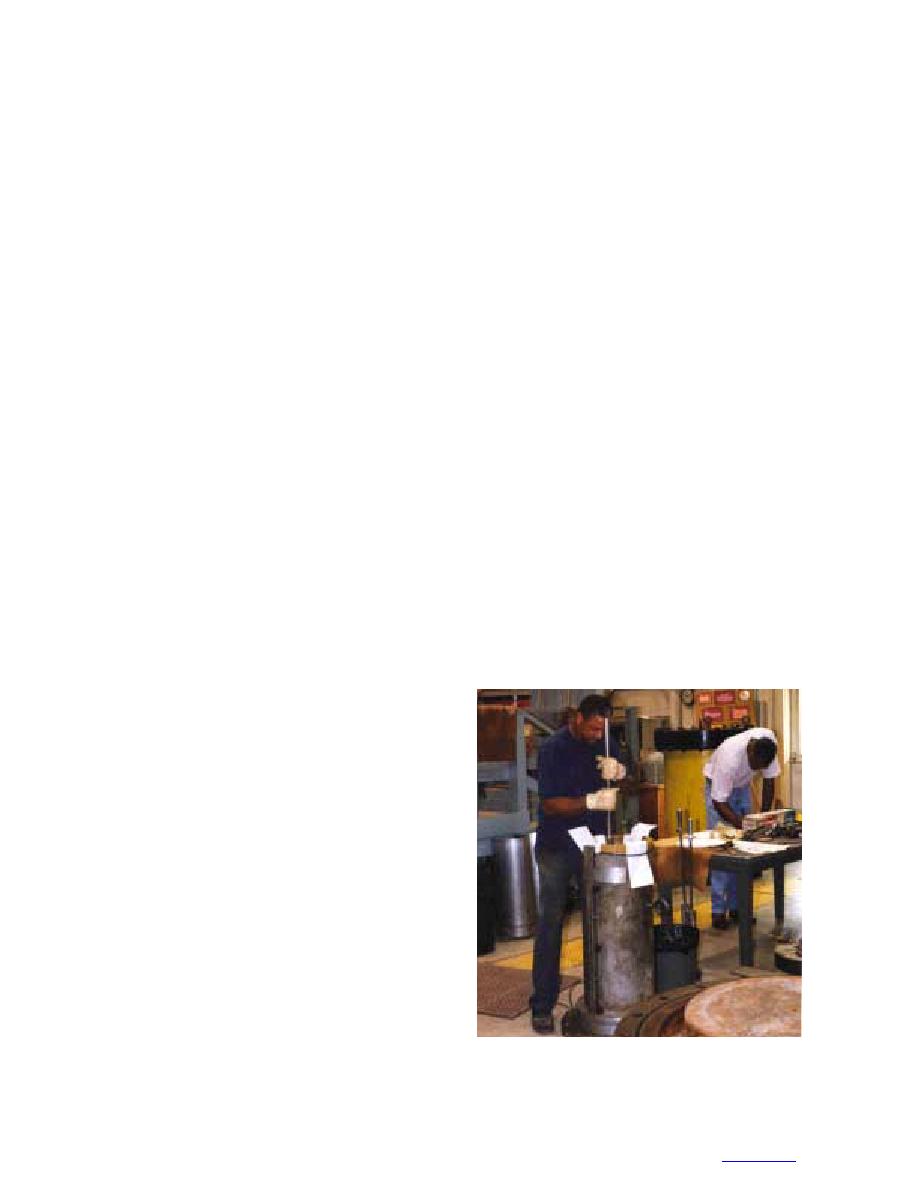
the test material was placed on the concrete floor in the
of the triaxial chamber and a vacuum of about 34.5 kPa
laboratory to air-dry prior to obtaining a pretest sieve
was applied to the specimen. Once the vacuum within
analysis. The material was turned regularly to expose
the specimen had stabilized, i.e., it was determined that
fresh soil to the atmosphere to speed drying. When the
the membrane was not leaking, the mold was removed
soil had been air-dried sufficiently (as determined by
from the specimen and the dimensions of the membrane-
the freshly turned soil's color and a representative wa-
encapsulated specimen were obtained. A second latex
ter content test), the material was quartered and subdi-
membrane was then placed over the specimen prior to
vided to obtain a representative sample that weighed
assembling the triaxial chamber (Fig. 10).
about 9 kg.
The triaxial chamber was assembled (Fig. 11), the
The representative sample was then passed through
closed loop hydraulic system was activated, and the (ax-
a nest of two sieves (50 mm and 4.76 mm). Soil that
ial) load cell was attached to the specimen top platen.
was retained or passed each sieve was placed in respec-
Initial instrumentation readings, i.e., chamber pressure,
tive containers labeled as +50 mm, 50 mm to +4.76
pore pressure, axial load, axial deformation using the
mm, and 4.76 mm. The weight of each container of
"closed-loop" LVDT and the "specimen" LVDT, were
soil was obtained (each container's tare weight had been
recorded. For all tests, the axial (overall) deformation
previously obtained). The material in the container(s)
of the specimen was measured using an LVDT with a
resolution and linearity on the order of 10 m. The
identified as the 50-mm to +4.76-mm fraction was
separated into fractions identified as 50 mm to +38
resolution and linearity of the chamber pressure and
the pore pressure transducers were about 2 kPa.
mm, 38 mm to +25 mm, 25 mm to +19 mm,
19 mm to +13 mm, 13 mm to +10 mm, 10 mm to
For the first series of resilient modulus tests, a 45-
+6.35 mm, 6.35 mm to +4.76 mm, and 4.76 mm by
kN load cell was used. For the second series, a higher-
sieving on a mechanical sieve shaker. The weights of each
capacity (89 N) load cell was selected. Note that all
fraction were obtained. The 4.76-mm fraction from the
instrumentation was zeroed prior to placing the com-
mechanical-sieving operation was combined with the
pacted specimen on the base of the triaxial apparatus.
4.76-mm fraction from the hand-sieving operation. The
After the chamber was assembled and instrumentation
air-dried weight and the water content of a representa-
readings were obtained, the vacuum that had been
tive sample of the combined 4.76-mm fraction were
applied to the specimen through the pore pressure sys-
obtained. A representative sample of the combined
tem was gradually reduced as chamber pressure was
4.76-mm fraction was obtained using the "quartering"
simultaneously increased. After the vacuum had been
method to subdivide the material to a sample of a few
reduced to atmospheric pressure, chamber pressure was
hundred grams required for the sieve analysis. The sieve
increased to 103 kPa prior to initiating the resilient mod-
analysis of the representative sample of the 4.76-mm
ulus test.
fraction was then conducted. The results of the sieve
analyses obtained on the 50-mm to +4.76-mm frac-
tion and the 4.76-mm fraction were used to obtain the
representative gradation of the material received.
Resilient modulus tests were conducted in a triaxial
apparatus equipped with a closed-loop hydraulic system
on specimens molded using each of the material types.
The nominal dimensions of the triaxial specimens were
300-mm diameter by 750-mm height. The target densi-
ties varied between 2323 and 2403 kg/m3. The weight
of dry aggregate required to mold each specimen was
on the order of 136 kg, depending on the target density
for the respective specimens. All specimens were molded
using twelve equal (air-dry) weight (and compacted
thickness) lifts of soil. Sufficient water was mixed with
the air-dried soil to increase the water content of each
lift to the required water content for each material type.
After each lift was placed in the mold, a hand-held ram-
mer was used to compact the soil to a specified thick-
ness (distance from the top of the mold) (Fig. 9).
When the specimen had been molded, the mold con-
Figure 9. Specimen preparation for resilient modu-
taining the compacted specimen was placed on the base
lus test.
7



 Previous Page
Previous Page
